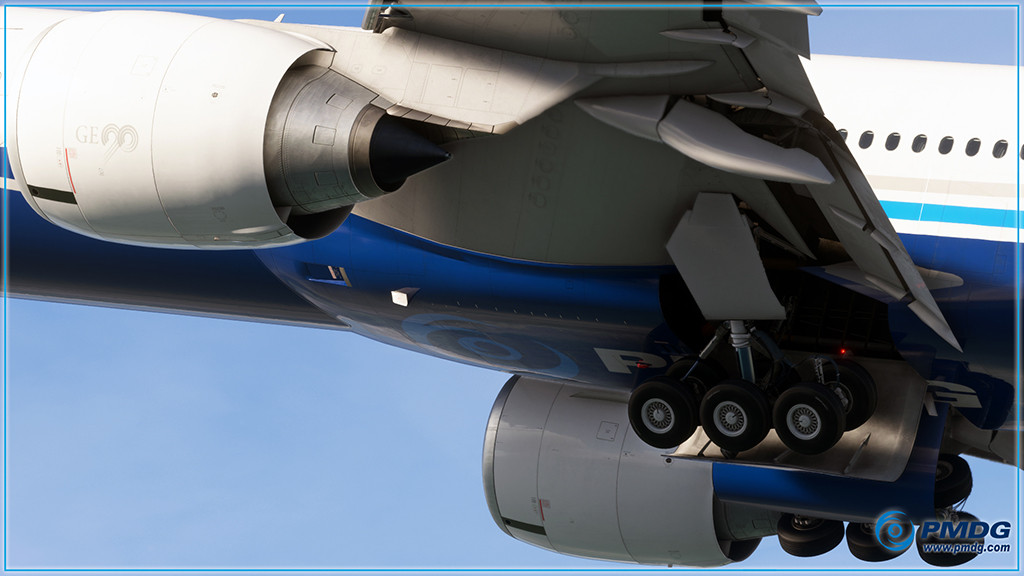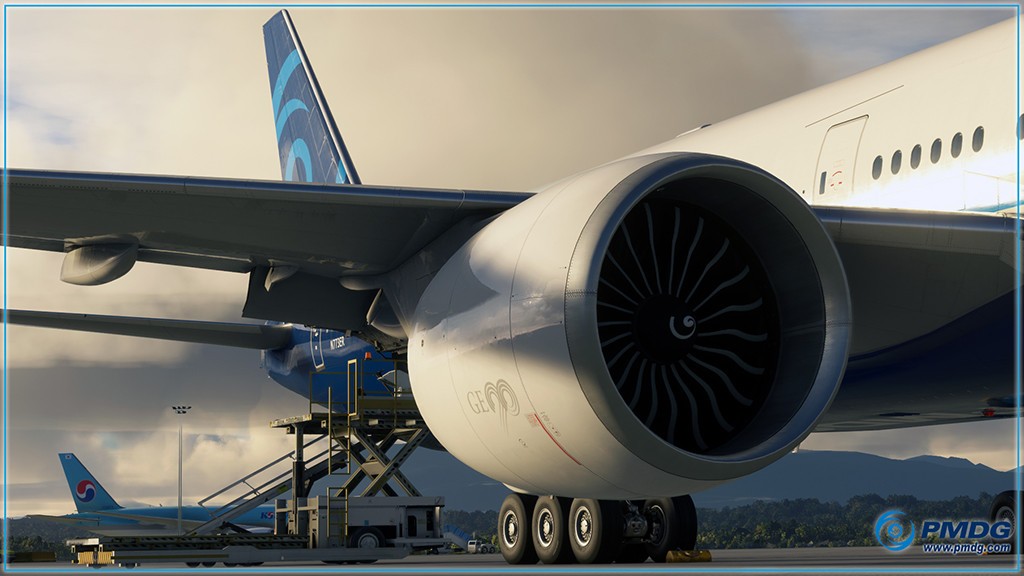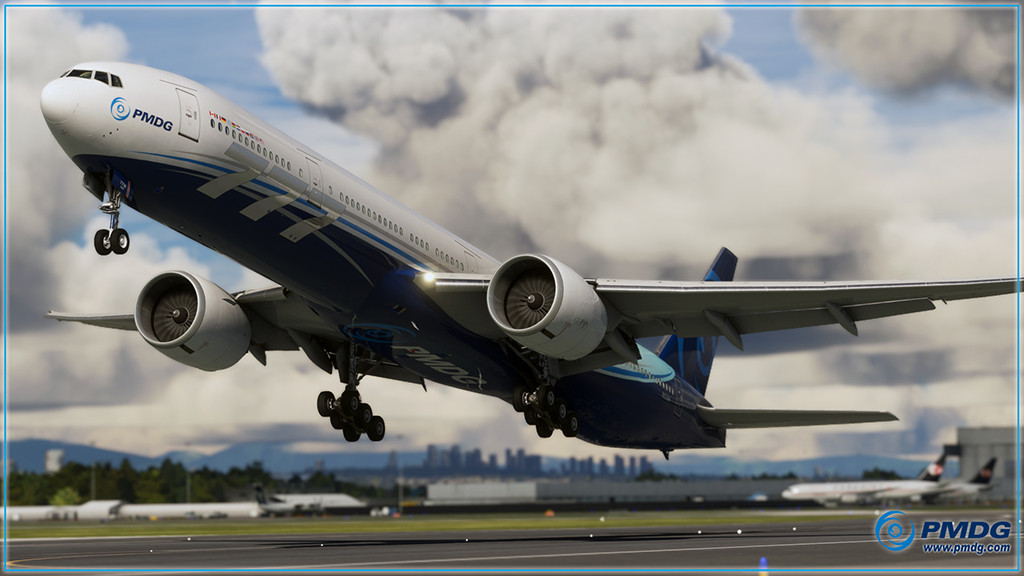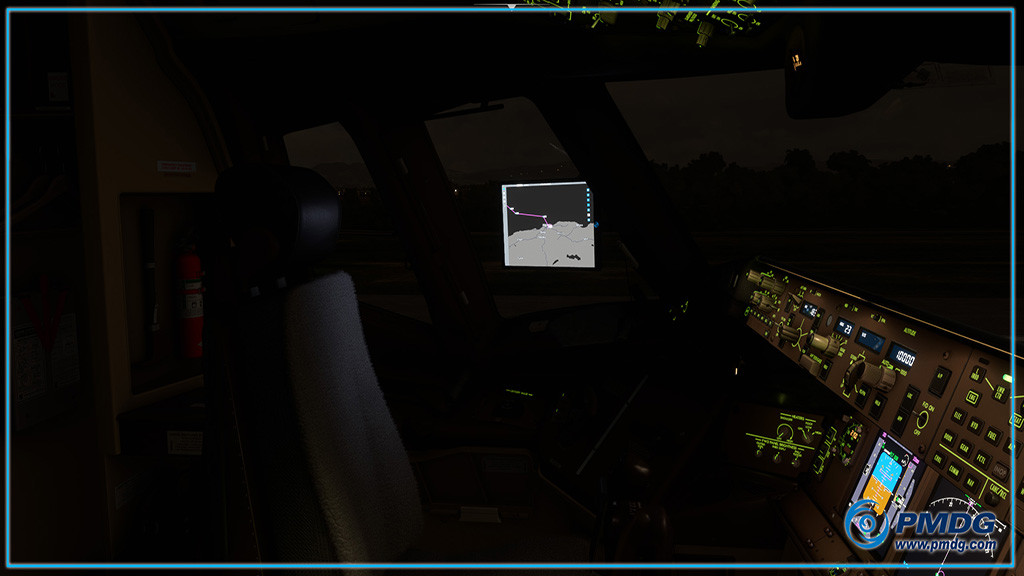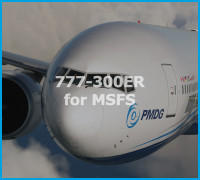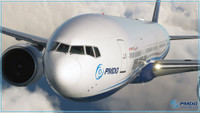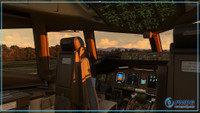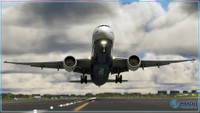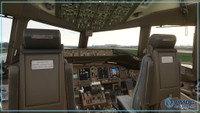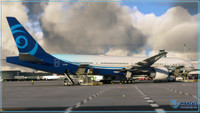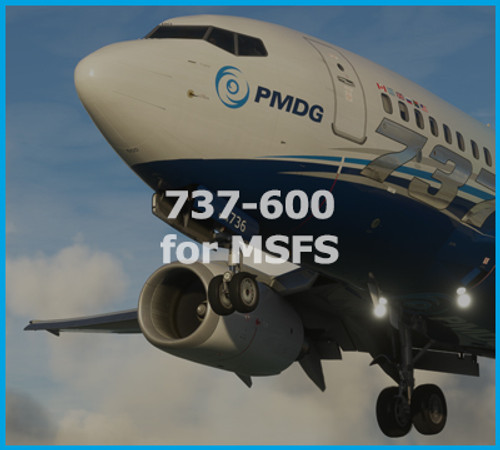The PMDG 777-300ER for Microsoft Flight Simulator
PMDG invites you onto the flight deck of the finest airliner simulation available for use with Microsoft Flight Simulator. Designed by the team from PMDG to leverage all of the capabilities of the MSFS platform, the PMDG 777-300ER is a feature rich and magnificently detailed simulation of the Boeing 777-300ER. Packed with features, authenticity and a plethora of options to .
Created by experts for the enjoyment of experts and casual simmers alike, the PMDG 777-300ER will please new flight simulation enthusiasts looking for their first true airliner experience while it simultaneously meets the exacting expectations of experienced simmers looking for the kind of depth and authenticity that only PMDG can provide.
Easily recognized as one of the most successful airliners to take to the skies, the Boeing 777-300ER is the largest twin engine airplane in airline service and gives it's airline operators tremendous efficiency and capacity while serving long, medium and short haul routes effectively well. Redundancy, well engineered maintainability and solid performance metrics make the 777 a favorite of airline executives while it's comfort and spacious interior are lauded by customers.
If you enjoy simulation flying on globe-spanning routes, the PMDG 777-300ER will quickly become your the favorite in your sim hangar, but you will find she is equally well suited for shorter regional flights when something a bit shorter fits into your simming plans. Or, you simulate long range flights using PMDG's innovative Auto-Cruise mechanism that ensures the flight and your simulation platform remain stable even when running the flight with time compression to shorten lengthy cruise segments to fit your personal schedule.
Like all PMDG products, this one is packed nose-to-tail with great features to add realism and excitement to your simming, from Ground Services, basic GSX integration, the PMDG Universal Flight Tablet, numerous animations and simulation features, hundreds of possible mechanical failures, electronic checklists, a fully featured and highly detailed passenger cabin with dynamic and automatically controlled lighting and passenger features, plus much, much more.
The PMDG 777-300ER was built using Lidar scanning and photogrammetry for high accuracy and capturing details so real you will feel as though you are sitting in command of your own airliner.
PMDG continues to raise the bar on product quality and excellence, with dozens of future updates planned to continue enhancing your simulation product to keep it fresh and up-to-date.
PMDG 777-300ER features
Avionics & Flight Deck:
- Advanced simulation of all avionics and system management operations of the 777 flight deck, including system states, sensor management, data bus communications, system state monitoring, message suppression and nuisance indication suppression logic.
- Full simulation of the 777 Master Caution and Warning System, including transient alert suppression for all systems and sensors to match the actual airplane.
- Accurately simulated display drawing process, to include color draw phasing, screen mapping, and data presence/loss display.
- Full electronic checklist with open loop and closed loop sensing, normal and non-normal procedures, as well as annunciated and unannunciated procedures for trouble shooting complex problems in flight.
- PMDG Universal Flight Tablet, with full simBrief integration and Navigraph support for users with charting subscriptions, as well as PMDG feature controls, performance tools, weather support and other useful flying tools.
- Crew Alertness Monitoring (which can be made optional for convenience!)
- Numerous flight deck features are animated with some items such as the tablet and sunshades moveable around the flight deck for convenience at different phases of flight.
- Fully featured cockpit lighting, including the unique master dimming system, moveable map and reading lights, panel back lighting and screen dimming.
Air Conditioning System:
- Cabin temperature will stabilize normally depending on the volume of air being pushed through the cabin by the environmental system, outside temperatures, and whether the aircraft is subjected to solar heating.
- Full simulation of cabin conditioning, including bringing ground air through the mix manifold to provide conditioned air during ground turns without the APU running.
- Cabin Air Conditioning follows the scheduled temperature management programmatically, warming and cooling the cabin based on the flight phase to ensure the passengers' physiological steadiness, or it can be controlled manually from the flight deck.
- Automatic and manual temperature control is modeled in full.
Auto-flight System:
- Full simulation of the Boeing 777 autoflight director and autopilot systems, including all mode switching, phase of flight changes and appropriately tuned gains for phase of flight.
- The entire 777 C*U fly by wire system is modeled, including Normal and Direct modes, along with all supporting data structures and system control and monitoring.
- Fully simulated path and speed management for manual flight, as well as buffet protection, flight envelope protection and artificial feel to enhance pilot awareness of the trim and energy condition of the airplane.
- Entirely customized fly-by-wire logic accepts control inputs to the simulator, then manages control outputs to yield appropriate results within the MSFS atmospheric model.
- Flight Management System uses Navigraph data and is capable of depicting and flying all real world derived and ground based procedures that are appropriate to the 777 aircraft type.
Brakes and Tires:
- Full autobrake and anti-skid system modeled, including all probes and sensors, data logic and internal testing systems.
- Brake wear modeled per real world specifications and will affect utilization of brake pads based upon braking and taxi habits.
- Dynamic modeling of tire wear based upon landing behaviors, brake selection, taxi distance and RTO events.
- Brake pin indicators and other landing gear preflight features modeled, including accumulation of brake dust as brakes wear.
- Maintenance features allow for replacement of tire/wheel assemblies, as well as brake units that have worn to limits. (When new tire/wheel assemblies are installed, brake dust no longer shows on the assembly that was changed.)
- Wear and loss of rubber surface on tires is visible during preflight.
- Brakes are subject to Brake Temperature Soak. After heavy brake use, the brake temperature will climb for some time.
- When the brake disks are very hot, they glow, with color accurately indicating the temperature of the brake assembly (lighter/brighter is hotter).
- Brake cooling depends on many factors, from ambient temperature to airflow. When you taxi, you will see the front brakes cool faster than the two aft brakes.
- The anti-skid system is active in all braking modes and assists with touchdown skids and hydroplaning. Each wheel is monitored and controlled independently.
- The complete anti-skid system, from wheel speed sensors to regulating valves and control logic, is modeled.
- Modulated braking system accurately simulated to distribute brake wear that accumulates from taxiing the airplane.
- Tire wear will accumulate based on taxi distances, the number of takeoff and landing cycles, and heavy braking, whether manual or under auto brake all based upon tire manufacturer's data.
Cabin:
- Fully detailed cabin, with four seating zones reflecting a common, modern layout with lay-flat seats up front and business class, premium economy and economy seating.
- Seats have installed IFE, which is correctly power sourced and includes appropriate boot up sequences and airline screens.
- The complete arming process of the doors is animated including the locking mechanisms and indicators.
- The cabin emergency lighting works and can be tested during preflight. Will illuminate for a loss of power.
- Full cabin and galley lighting can be manually or automatically controlled. Automatic control simulates the lighting environment for a normal flight with higher illumination during meal and prep/cleanup times, and phased color lighting to reflect sunrise and sunset phases during cruise flight.
Datalink (Currently limited to Hopie Network for ATC services, but more coming!):
- Clearance Request
- Emergency Report
- Free Text Message
- Level Request
- Position Report
- Route Request
- Speed Request
- Voice Request
- When Can We...
- Departure Clearance Request
- Expected Taxi Request
- Oceanic Clearance Request
- Pushback Request
- TWIP Request
- ATIS Request
- Documentation
- Instead of a flat PDF, all documentation comes in an interactive e-learning system that is fully usable on smartphones, tablets, and PCs. It contains audio and video.
Doors:
- Normal and abnormal operation of the doors, including nuisance sensor warnings that can be cleared by following reset procedures.
- Simulated flight attendants will manage the doors automatically or manually on your command wishes.
- Full operation of all doors and servicing will take place automatically when using PMDG Ground Operations.M
- The arming system of the doors is animated, and the arming indicators at the bottom of the doors.
Electrical System:
- Boeing 777 ELMS (Electrical Load Management System) fully simulated to control all AC and DC generation and distribution systems throughout the airplane.
- All electrical bus systems are modeled, along with correct voltage and amperage loads.
- Accurate simulation of the manner in which the 777 powers up and powers down.
- Using PMDG failures, you can fail any bus on the aircraft and suffer the appropriate penalties as equipment powered by that bus falls offline.
- Load-shedding behavior for a loss of electrical generation will vary depending on what systems are consuming power when load-shedding occurs.
- All electrical system self-tests are modeled, along with system protection logic and reconfiguration controls.
- Electrical protection of critical aircraft systems during autoland operations is fully modeled.
- The Electric Load Management System (ELMS) and its reconfiguration and electrical protection processes are fully modeled.
- Dependency of all systems to their appropriate AC and DC electrical systems is accurately modeled.
Engines:
- Numerous engine abnormal conditions are modeled, along with consequences for mishandling of the event or failure to follow checklist procedures.
- Accurate engine performance in all phases of flight, using an entirely customized engine simulation model that results in highly accurate fuel flow behaviors during flight.
- Flexing of engine pylons under accelerated loads is visible from cabin windows and on the exterior model.
- Entirely custom autothrottle model for accurate and realistic control of engine thrust.
Failures:
- Hundreds of mechanical failures are modeled, many with downstream consequences for mishandling or ignoring the failure in flight.
- Fully dynamic failures model based upon real-world Mean Time Before Failure data for hundreds of components onboard the airplane, resulting in approximately realistic rates of failures in normal flying.
- Fully manual failures can be triggered at random intervals, scheduled intervals, or upon specific flight driven-events, such as V1 engine failures.
- PMDG Ground Maintenance can be used to repair all failures whether in flight or on ground.
Flight Controls and Flight Surfaces:
- Trim control functions modeled accurately to reflect the proper input speeds based upon flight control system logic.
- Fly-By-Wire inputs to flight control systems are accurately modeled, including aileron pitch changes, flaperon bypass and flight path augmentation modes.
- Flight control normal, secondary and alternate modes modeled, along with their commensurate impact on flight control effectiveness.
- Aerodynamic forces moderate rudder control inputs using an accurately modeled Q-System to facilitate yaw stability.
- TAC system modeled to make takeoff engine failures easier to manage appropriately.
- Accurately modeled trim neutral point shift at Mach 0.615.
- The VOR roll mode and appropriate sub-modes are all modeled.
- Inboard flaperons on each wing and their primary and secondary control law functions are fully modeled.
- The ailerons on the 777 are “floating ailerons” in that they change position based on the phase of flight and configuration of the wing flaps. This improves aileron effectiveness and reduces wing flexing during various phases of flight.
- Overspeed protection logic for wing flaps is fully modeled.
- The correct primary, secondary, and reversionary control characteristics of the 777 flight control systems are fully modeled, along with the different feel of the controls as they degrade to lower modes.
- All flight control modes fully model the air and ground spoiler logic.
- The entire AFDS system is modeled in detail, including the C*U logic that allows the fly-by-wire system to closely mimic the feel of a conventional airplane while washing out the bad habits of older-generation airliners, such as pitch-coupling related to thrust changes. This system makes the 777 such a marvelously stable platform to fly, as the fly-by-wire logic helps improve both speed and pitch stability while retaining the conventional pilot input-response mechanism common to nearly all other aircraft that a pilot may have flown.
- The ground spoilers only deploy partially until the aircraft deck angle is reduced, at which point they are allowed to deploy fully. You can see this behavior in many YouTube videos and on your PMDG 777.
- The horizontal stabilizer flexes with air disturbance due to engine exhaust and when spoilers are extended in flight or on the ground.
- The rudder moves in windy conditions when hydraulic power is off.
Fly By Wire System:
- The PMDG 777 comes with a complete Fly-By-Wire system that includes Mode Degradation. For more information, see the special chapter on FBW.
Fuel System:
- Global fuel density model is included with the airplane. When using automatic ground operations, the fuel boarded will reflect average density for the geographic area in which fueling is taking place.
- Fuel slosh effect is modeled in the center wing tank, along with the various caution and advisory systems related to fuel management from the center tank during steeper climbs.
- Pitch effect on fuel value sensing is modeled.
- Flow rate and pressure for all fuel pumps is accurately modeled for all normal fuel pumps as well as override jettison pumps.
- Accurate model of fuel tank interconnection, all related valves and fuel flow processes within the fuel system.
- Fuel leaks of varying types are simulated and can be identified through accurate use of the electronic checklist for Suspect Fuel Leak.
Ground Service Vehicles:
- PMDG Ground Services vehicles can be arrayed around the aircraft for an accurate servicing appearance by users without a dedicated ground services product like GSX.
- PMDG Ground Operations will simulate the entire ground servicing process for the 777 from door open to door close, and everything in-between, adding a realistic flavor to your preflight preparations.
- Vehicles that are possible to display are as follows:
- Ground power, air conditioning, and air start units
- Galley service & cabin cleaning trucks
- Mobile air stairs
- Cargo belts & Cargo loaders
- Fuel pump truck
- Lavatory, potable water, and maintenance vehicles.
- All these are fully integrated into the aircraft (doors/cargo bays will open in time, fuel truck will connect to under-wing refuel panel, etc.) and will become alive under the Automatic Ground Operations feature, or you can call any individual vehicle/service manually whenever needed.
- GSX profile included for GSX Pro.
- General integration of GSX connectivity is provided.
Hydraulic System:
- Full and complete simulation of the hydraulic system, along with associated logical systems for control and operation.
- Complete hydraulic fluid simulation with realistic times for pumps to come online and drop offline.
- Violating pump operating limitations will cause the case drain fluid to overheat, resulting in an OVERHEAT warning.
- Engine drive, air driven and electrically driven pumps are all accurately modeled, along with correct volume flow and pressure increase/decrease rates based upon manufacturers data.
- Accurate implementation of pressure and temperature sensing units throughout the system, along with correctly configured operational blocking logic due to overheat conditions.
- Hydraulic Quantity indication is affected by gear/flap/spoiler/flight control position and thermal shrinking. You will notice changes in hydraulic quantity indicated during flight as you change the aircraft's configuration, set the parking brake, etc.
- The hydraulic quantity is accurately measured by sensors, with temperature compensation to account for fluid expansion/shrink based upon temperature.
Landing Gear:
- Accurate animation of landing gear operation in all phases of flight.
- Fully simulated alternate gear extension for the 777.
- Dynamic aerodynamic sounds based upon whether gear doors are open or closed and the speed of the aircraft.
- Steerable aft wheels on the main landing gear provide advantage when making large turns at slow speeds. and minimize stress on tires and pavement.
- The 777-300's unique cantilever landing gear function is accurately modeled to improve tail clearance during rotation of this extremely long airliner.
- Fully functioning tail strike prevention and detection system with animated tail skid.
- Brake and tire wear fully modeled, along with brake overheat indications.
Lighting Systems:
- Accurately timed strobe light configurations for the 777-300.
- All external lighting is modeled, including the loading platform work lights for lower deck cargo loading and unloading.
- Cabin and external emergency lighting systems are fully modeled, including their limited battery life in emergency operation.
- Fully controllable cabin lighting which can also be controlled automatically using the PMDG Sky Interior system to simulate cabin lighting during all phases of flight, including during sunrise and sunset.
- Full exterior lighting effects.
Navigation Data:
- The PMDG 777 uses the latest Navigraph navdata system that makes RNAV and other procedures possible using real world data.
Physics-based Flexing:
- The wing utilizes a fully physics-based wing flex model and will bend and twist appropriately in flight.
- Engine pylons flex and bend appropriately due to acceleration loading in turbulence and during taxi.
- The aircraft's tail-plane reacts to thrust, turbulence, and ground roll with a visible vibration.
- Various items in the cockpit, such as sun visors will respond to turbulence in flight.
Pneumatic System:
- A full featured pneumatic bleed system is modeled, including location and pressure of service taps from the engines, cooling expansion and flow controls.
- The bleed pressure produced by each engine is modeled dynamically.
- All ducting, sensors, valves and pressure regulating shut off valves are modeled.
- Various forms of bleed pressure leaks can be simulated and identified using the electronic checklist for suspected bleed leak.
Simulator Features:
- Advanced time compression that makes oceanic flights possible. London-New York in two hours or 2,5 if you want to do the climb and descent in real-time. 4X (8X over the ocean) will be rock steady on most machines.
Note: Digitally delivered products are not refundable.
SYSTEM REQUIREMENTS
RECOMMENDED
Simulator: Microsoft Flight Simulator
Hardware: Intel i7 or i9 processor with 8 or more cores operating at 3.5 GHz or faster processor, 16 GB of RAM or higher, a high-performance, DirectX 11 or 12-capable video card with 8 GB or more of on-board, dedicated VRAM. (2080Ti or newer, for example.)
If your installation of Microsoft Flight Simulator runs reasonably well using other popular aircraft add-ons, then it will run the PMDG 777-300ER just fine.
Customer Reviews Write a Review
777 for MSFS
The wait was well worth it!!! My favorite plane to fly and PMDG keeps adding updates and improving as close to perfection that is possible. THANK YOU PMDG for the best aircraft in MSFS 2020
The Only 777 For MSFS
This is the only 777 for MSFS. Full stop.
Nice, big, fantastic, fast Plen
Plen is very nice and have a good model. Plen is very big and weryyyyyy loud. Plen is perfect! So if you wish to have a plen like this, buy that Plen its wonderful.
Perfection.
This may be expensive. But, It is WORTH IT. Honestly worth every dime. This is the best aircraft I've ever have experienced in my whole life. Especially to the fact that the B777-300ER is my favorite aircraft, this is perfect for it. Everything works perfectly. So far, I've spent 80 hours with the B777 and I've had no issues with it at all! It was worth it buying it.
Stunning
still best of the best! I loved it in FSX and now finally it made it's way to MSFS. I must say, I absolutely love it even more So far I have 168 flight hours with it, it's fantastic. But now I can't wait for the 777-Freighter.
Wonderful
The best 777 for flight simulation. It includes every single feature that I can possibly think of and really elevates my simming experience.
Absolutely Love the 777
I love my flight sim, no doubt. Much to my family’s dismay, I spend a lot of time flight simming - but the PMDG 777 changed the scene. This plane has reinvigorated and renewed my excitement for this game and PMDG freaking nailed it.
Simulation Handling
On top of everything you've already heard about PMDG and their excellence and attention to detail -- I'd like to call attention to the fact that these planes fly gorgeously over long distances by NOT PORPOISING during accelerated time warp! Most jetliners will violently porpoise on autopilot beyond 4x warp. PMDG has somehow broken this curse which affects all others including default aircraft, allowing you to fly longer routes in a reasonable time. All the more reason to spend your flight sim time in a PMDG cockpit and nowhere else.
the best msfs 777 ever!!!
best ever
absolutly amazing
worth the money. It is a must have!



